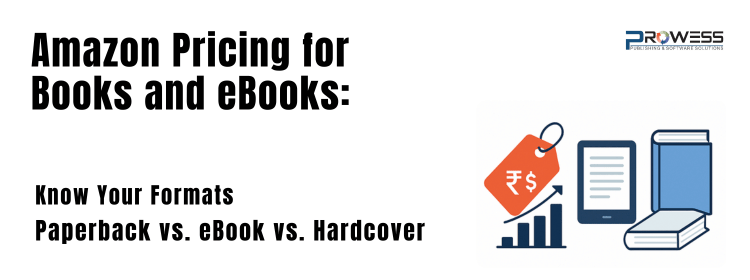
In today’s self-publishing landscape, Amazon stands as a powerful marketplace for authors. But pricing your book on Amazon—whether it’s a paperback, eBook, or hardcover—is more than just assigning a number. It’s about strategy, perception, and profit. Each format comes with its own pricing considerations, benefits, and reader expectations. Here’s what every author should know before finalising their pricing strategy on Amazon.
1. Understanding the Formats
Before diving into pricing, it’s important to understand what each format means:
- Paperback: A printed book with a soft cover. It’s cost-effective, widely accepted by readers, and relatively easy to produce through Print-on-Demand (POD) services like Amazon KDP.
- eBook (Kindle): A digital version of your book, delivered instantly. It has the lowest production cost and is globally accessible.
- Hardcover: A premium version with a rigid cover. It gives a prestigious feel and is favoured for collectors, gifting, or academic texts, though the production cost is higher.
2. Why Pricing Matters
Price plays a crucial role in a book’s success. It directly influences:
- Reader perception: A well-priced book appears valuable and trustworthy. Overpricing can scare readers away, while underpricing might devalue the content.
- Sales volume: Competitive pricing increases chances of purchases, especially for debut authors.
- Royalties: Striking the right balance between affordability and profitability is key.
The price you set is not just about profit—it’s a marketing tool that reflects the value of your book and helps position it correctly in the market.
3. How to Fix the Price of Your Book
While deciding the price, authors should consider the following:
- Page count: A longer book (e.g., 250+ pages) often justifies a higher price. However, don’t assume that more pages always mean more value. Readers care about quality and relevance.
- Genre: Pricing varies by genre. Fiction genres like romance or thrillers typically range between ₹149–₹299, while non-fiction or self-help books can go up to ₹399–₹699 depending on the niche.
- Content value: Is your book research-based, instructional, or inspirational? Books that solve problems or deliver expertise can command higher prices.
- Target audience: Price should suit the purchasing power of your target readers. If you’re writing for students, affordability matters. If it’s for professionals, they may value depth over price.
- Production cost: Especially relevant for paperbacks and hardcovers. Amazon has a minimum pricing threshold based on printing expenses.
- Your publishing goals: Are you aiming for maximum reach, brand building, or high royalties? Your price should reflect that goal.
4. Amazon Pricing for eBooks (Kindle)
Amazon encourages authors to price Kindle books between $2.99 and $9.99 (₹99–₹650 in India) to qualify for a 70% royalty. Outside this range, the royalty drops to 35%.
Tips:
- Use ₹99 or ₹149 for first-time authors to attract initial readers.
- Use Kindle promotions like “Free Book Days” or “Countdown Deals” for visibility.
- Keep pricing competitive with similar titles in your genre.
5. Amazon Pricing for Paperbacks
For paperbacks, pricing is determined by:
- Printing cost (depends on page count, trim size, and color)
- List price (your selling price)
- Amazon’s cut (usually 40% of the list price)
Formula:
Royalty = 60% of List Price – Printing Cost
Example: If list price is ₹299 and print cost is ₹80, royalty = (60% of 299) – 80 = ₹99.40
6. Amazon Pricing for Hardcover Books
Hardcover pricing is slightly premium. It gives you:
- Higher perceived value
- A product for gifting, libraries, and schools
- Added brand credibility
Ideal range: ₹499–₹999, depending on genre, content depth, and print cost.
7. Country-Specific Pricing Strategy
Amazon lets you set pricing for each country, which helps align with purchasing power.
- In India: Keep it affordable—₹149 to ₹399 is a good starting point.
- US/UK markets: Align with genre pricing norms—$3.99 to $6.99 for Kindle fiction; $14.99–$24.99 for quality paperbacks and hardcovers.
Use Amazon’s KDP Pricing Support tool to get smart pricing suggestions.
8. Final Thoughts
Pricing your book isn’t a guess—it’s a strategic decision. A thoughtful price reflects your book’s value, fits your target market, and enhances your chances of success.
At Prowess Publishing, we work closely with authors to set the right price for each format—eBook, paperback, or hardcover—balancing royalty, visibility, and reader expectations. If you’re unsure how to price your book or want a detailed analysis based on your manuscript, we’re here to help.



Speak Your Mind